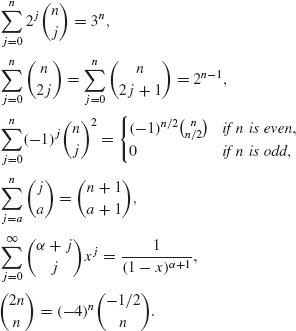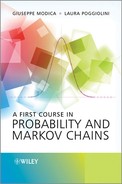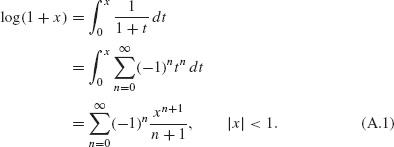Appendix A
Power series
We recall some results from the theory of power series which should already be known to the reader. Proofs and further results can be found in textbooks on Analysis, see e.g. [25, 26].
A.1 Basic properties
Let {an} be a sequence of complex numbers. The power series centred at zero with coefficients {an} is
![]()
i.e. the sequence of polynomials {sn(z)}n
![]()
Given a power series ![]() , the non-negative real number ρ defined by
, the non-negative real number ρ defined by
![]()
where 1/0+ = +∞ and 1/(+∞) = 0, is called the radius of convergence of the series ![]() . In fact, one proves that the sequence {sn(z)} is absolutely convergent if |z| < ρ and it does not converge if |z| > ρ. It can be shown that ρ > 0 if and only if the sequence {|an|} is not more than exponentially increasing. In this case, the sum of the series
. In fact, one proves that the sequence {sn(z)} is absolutely convergent if |z| < ρ and it does not converge if |z| > ρ. It can be shown that ρ > 0 if and only if the sequence {|an|} is not more than exponentially increasing. In this case, the sum of the series
![]()
is defined in the disc {|z| < ρ}.
Power series can be integrated and differentiated term by term. More precisely, the following holds.
Theorem A.1 Let ![]() be the sum of a power series with radius of convergence ρ. Then the series
be the sum of a power series with radius of convergence ρ. Then the series ![]() and
and ![]() have the same radii of convergence ρ. If ρ > 0, then A(z) is holomorphic in B(0, ρ),
have the same radii of convergence ρ. If ρ > 0, then A(z) is holomorphic in B(0, ρ),
![]()
and, given any piecewise C1 curve γ : [0, 1] → B(0, ρ),
![]()
Then Corollary A.2 easily follows.
Corollary A.2 Let ![]() be the sum of a power series of radius of convergence ρ > 0. Then
be the sum of a power series of radius of convergence ρ > 0. Then
![]()
Thus, if ρ > 0 the sum A(z), |z| < ρ, completely determines the sequence {an}. The function A(z) is called the generating function of the sequence {an}. In other words, {an} and ![]() contain the same ‘information’ (we are assuming that {an} grows at most exponentially or, equivalently that ρ > 0): we can say that the function A(z), |z| < ρ, is a new ‘viewpoint’ on the sequence {an}.
contain the same ‘information’ (we are assuming that {an} grows at most exponentially or, equivalently that ρ > 0): we can say that the function A(z), |z| < ρ, is a new ‘viewpoint’ on the sequence {an}.
By Corollary A.2 if ![]() and B(z) =
and B(z) = ![]() are the sums of two power series with positive radii of convergence, that coincide near zero, then an = bn ∀n, both series have the same radius ρ, and A(z) = B(z) for any z such that |z| < ρ.
are the sums of two power series with positive radii of convergence, that coincide near zero, then an = bn ∀n, both series have the same radius ρ, and A(z) = B(z) for any z such that |z| < ρ.
Example A.3 (Geometric series) The geometric series is the most classical example of power series. It generates the sequence {1, 1, 1,... }
![]()
![]()
Example A.4 (Exponential) Taking advantage of Taylor expansions, one can prove that
![]()
Example A.5 (Logarithm) Replacing z with −z in the equality ![]() |z| < 1, we get
|z| < 1, we get
![]()
Integrating along the interval [0, x] ⊂ ![]() , we get
, we get
A.2 Product of series
Definition A.6 The convolution product of two sequences a = {an} and b = {bn} is the sequence {a ∗ b}n defined for n = 0, 1, . . . by
![]()
In the first sum we sum over all couples (i, j) of non-negative integers such that i + j = n.
The first terms are

The convolution product is commutative, associative and bilinear. Moreover the following holds.
Theorem A.7 (Cauchy) Let a = {an} and b = {bn} be two sequences and let ![]() and B(z) =
and B(z) = ![]() be the sums of the associated power series defined for |z| < ρa and |z| < ρb, respectively. Then the power series of their convolution products converges for any z such that |z| < min(ρa, ρb) and
be the sums of the associated power series defined for |z| < ρa and |z| < ρb, respectively. Then the power series of their convolution products converges for any z such that |z| < min(ρa, ρb) and
![]()
A.3 Banach space valued power series
Let V be a Banach space with norm || || and let {fn} ⊂ V. Then one may consider the series, with values in V,
Let ρ ≥ 0 be defined by
![]()
As in the case of power series with complex coefficients, the power series in (A.2) absolutely converges in V for any ![]() Thus the sum of the series is a well defined function on the disc |z| < ρ of the complex plane with values in V
Thus the sum of the series is a well defined function on the disc |z| < ρ of the complex plane with values in V
![]()
As for complex valued power series, one differentiates term by term Banach valued power series: the sum F(z) is a holomorphic function on the open disc |z| < ρ and
![]()
As a special case, one considers the space MN,N (![]() ) of N × N complex matrices with norm
) of N × N complex matrices with norm
![]()
called the maximum expansion coefficient of F. It is easy to prove that
![]()
and that MN,N (![]() ) equipped with this norm is a Banach space. Given a sequence {Fn} ⊂ MN,N (
) equipped with this norm is a Banach space. Given a sequence {Fn} ⊂ MN,N (![]() ), the associated power series
), the associated power series
converges if |z| < ρ where
![]()
From the above, we have the following:
(i) ρ > 0 if and only if the sequence {||Fn||} grows at most exponentially fast.
(ii) If |z| < ρ, then the series (A.3) converges, both pointwise and absolutely, to a matrix F(z) ∈ MN,N (![]() ),
),
![]()
i.e. we have ∀i, j ∈ {1, . . . ,N} the complex valued limits
![]()
A.3.1.1 Power expansion of the inverse of a matrix
Let P ∈ MN,N (![]() ) be a N × N square matrix with complex entries. If ||P|| |z| < 1, then
) be a N × N square matrix with complex entries. If ||P|| |z| < 1, then ![]() Thus the series
Thus the series ![]() converges, both pointwisely and absolutely, to a matrix
converges, both pointwisely and absolutely, to a matrix ![]() For any positive n we can write
For any positive n we can write
![]()
so that
![]()
Since ||P|| |z| < 1, as n → ∞ we get
![]()
Therefore, we conclude that, if ![]() then Id − zP is invertible and
then Id − zP is invertible and
![]()
A.3.1.2 Exponential of a matrix
Let Q ∈ MN,N (![]() ). The radius of convergence of the power series
). The radius of convergence of the power series
![]()
is +∞, so that, for any z ∈ ![]() the power series
the power series ![]() converges, both absolutely and pointwisely, to a matrix denoted by eQz,
converges, both absolutely and pointwisely, to a matrix denoted by eQz,
Proposition A.8 The following hold:
(i) eQ0 = Id.
(ii) eQz and Q commute.
(iii) ![]() for any z ∈
for any z ∈ ![]() .
.
(iv) eQ(z+w) = eQz eQw for any z, w ∈ ![]() .
.
(v) eQz is invertible and its inverse is (eQz)−1 = e−Qz.
(vi) (eQz)n = eQnz for any z ∈ ![]() and any n ∈
and any n ∈ ![]() .
.
Proof. Properties (i) and (ii) are a direct consequence of the definition of eQz. Property (iii) follows differentiating term by term the series ![]() . Property (iv) is a consequence of the formula for the product of power series: in fact,
. Property (iv) is a consequence of the formula for the product of power series: in fact,

Finally, properties (v) and (vi) are particular cases of (iv).
A.3.2 Exercises
Exercise A.9 Prove the Newton binomial theorem:
(i) directly, with an induction argument on n;
(ii) taking advantage of the Taylor expansions;
(iii) starting from the formula D((1 + z)n) = n(1 + z)n−1;
(iv) starting from the identity et(x+y) = etxety.
Exercise A.10 Prove the following equalities:

Exercise A.11 Show that
![]()
Exercise A.12 Let {an} be a complex valued sequence such that {|an|} grows at most exponentially fast. Let ![]() |z| < ρ be its generating function. Compute the generating function of the following sequences:
|z| < ρ be its generating function. Compute the generating function of the following sequences:
- {αa0, αa1, αa2, αa3,...}, α ∈
 ,
, - {a0, 0, a1, 0, a2, 0,...},
- {a0, 0, a2, 0, a4, 0,...},
- {a1, 0, a3, 0, a5, 0,...},
- {0, 0, 0, a0, a1, a2, a3,...},
- {a3, a4, a5, a6,...},
- {a0, 2a1, 3a2, 4a3, 5a4,...},
- {a0, a1/2, a2/3, a3/4, a4/5,...},
- {a0, a0 + a1, a1 + a2, a2 + a3,...},
- {a0 + a1, a1 + a2, a2 + a3, a3 + a4,...},
- {a0, a0 + a1, a0 + a1 + a2, a0 + a1 + a2 + a3,...},
Solution.
We prove this equality directly. Since for any p = 1, . . ., n − 1 we have ![]() one gets
one gets

The same result can be obtained via generating functions. From the formula for the product of two power series, we get

The claim follows by the identity principle for polynomials.
Exercise A.14 For any p, q, k ≥ 0, prove Vandermonde formula
Solution. We prove the equality (A.5) by using generating functions. From the formula for the product of power series, we get

hence the claim.
Exercise A.15 Show that ![]()
Solution. Applying the Vandermonde formula (A.5), we get
![]()
Exercise A.16 Show that ![]()
Solution. Applying Vandermonde formula we get
![]()


